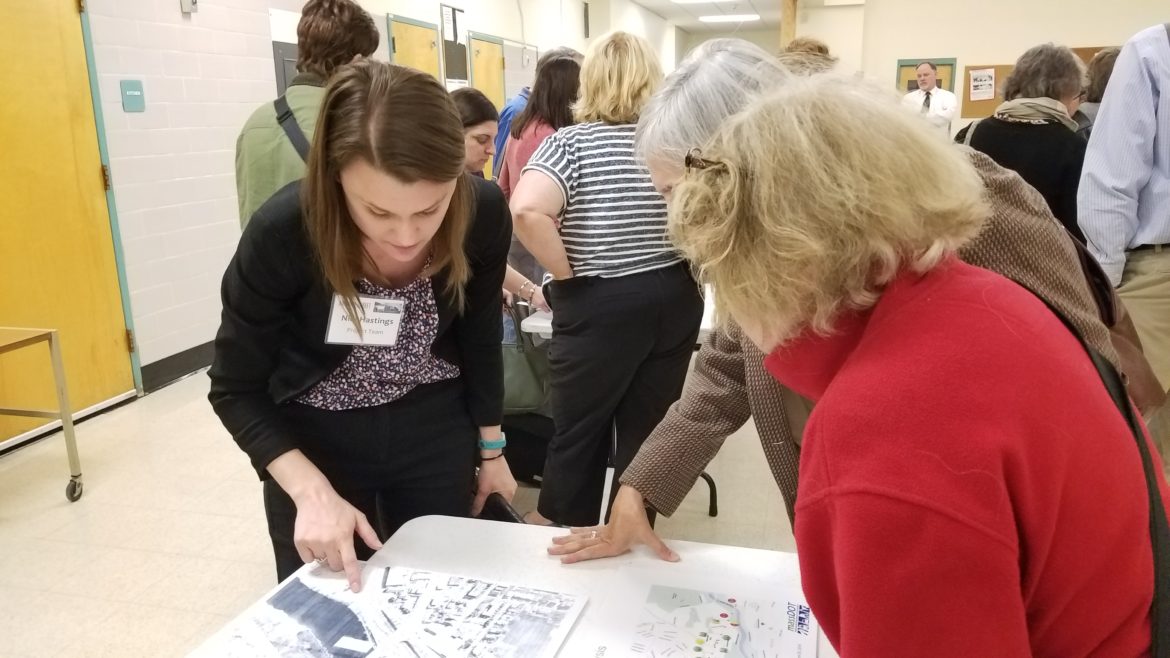
Charlie Breitrose
A consultant for the Mass. Department of Transportation goes over some of the options to improve Arsenal Street with residents Tuesday at Watertown Middle School.
Residents attending the MassDOT’s community forum Tuesday night heard some things they already knew – traffic and bus service is bad on Arsenal Street – and other things they didn’t want to know – it will get much worse unless something is done.
The Department of Transportation’s consultants from VHB told residents that traffic could increase significantly the next 25 years and that will result in more crowded and more late MBTA buses. They also discussed ways to improve public transportation and traffic on the Arsenal Street Corridor during the second community meeting on improvements to the area.
Traffic will increase 17 percent in the morning peak traffic hour and 21 percent in the evening peak traffic hour, said Laura Castelli, a consultant from VHB.
Looking at traffic flow, most of the congestion currently is at the two “gateways” to the Arsenal Corridor: Watertown Square and the Western Avenue/Soldier Field Road interchange on the other side of the Arsenal Street Bridge, Castelli said.
Currently, 15-35 percent of stops are above capacity the way the MBTA measures it – all seats are full during non-peak time and in peak times, the bus is at capacity for sitting and standing. The projections show overcrowding at all times of day, said Caroline Ducas of VHB.
Consultants explored a variety of steps that could be taken to improve traffic flow, MBTA bus service and ease bicycle and pedestrian travel.
Traffic Improvements
Making improvements to the two gateways could help traffic move more efficiently, Castelli said. Some changes being explored for Watertown Square include realigning Charles River Road so it no longer goes into the Watertown Square intersection. Also, light traffic could be changed so people don’t get stuck behind drivers trying to go straight in a left turn only lane.
Another option is a “road diet” where one of the two lanes on Arsenal Street is turned into bus and bicycle only, and the other one is for traffic.
“It is beautiful for public transportation, but the question is the impact to traffic,” Castelli said. “Where will the traffic go and what impact will it have to the neighborhoods.”
Making the section of Arsenal Street east of School Street one lane each way (instead of the current two) is another option.
Bus Improvements
There are a number of options for improving bus service. Some that could be done in the near term by the MBTA include: alternative fare collection so that there is less delay loading buses, reducing or repositioning stops, and adding bus shelters.
Other include changing routes and adding service. Suggestions from the consultant include looking at splitting up the routes of the 70 and/or 70A to shorten the total trip and combining the bus with other routes.
The addition of an express bus from Watertown to the new commuter rail stop at Brighton Landing (near New Balance) using North Beacon Street was another suggestion.
Buses could travel more swiftly through the area using technology that gives buses the ability to control traffic lights so they can get through intersections more quickly.
Bicycle and Pedestrian Improvements
An off-street bicycle lane is being built west of School Street to Irving Street, and consultants looked at doing the same thing east of that intersection. The conditions, however, are not favorable.
There are buildings along the stretch, some of them are historic, which are right up within a few feet of the roadway, Castelli said. That makes it too narrow to put in a separate 10-foot wide bicycle lane on the sidewalk level.
Connecting the bicycle path on Arsenal Street to the Charles River Path is another priority. They would need to be made through private property, but some of those areas – the Arsenal Mall and the Arsenal on the Charles – are being redeveloped or renovated. Both developers have agreed to look at ways to make the connections.
Pedestrian improvements include making sure all crossings have wheel chair accessible ramps, and have the plastic bumpy strips on them, Castelli said. At some intersections the walk signal is misaligned, which is easy to fix.
Next Steps
After finding out more about each option, residents could vote for their favorite options.
The consultants will look at the feedback and examine the options before coming back in the spring for the third community meeting where they will present their recommendations. After that, there will be a 30-day comment period, Castellli said.
More information about the Arsenal Corridor Study and information from the meeting can be found here: https://www.massdot.state.ma.us/planning/Main/CurrentStudies/ArsenalStreetCorridorStudy.aspx